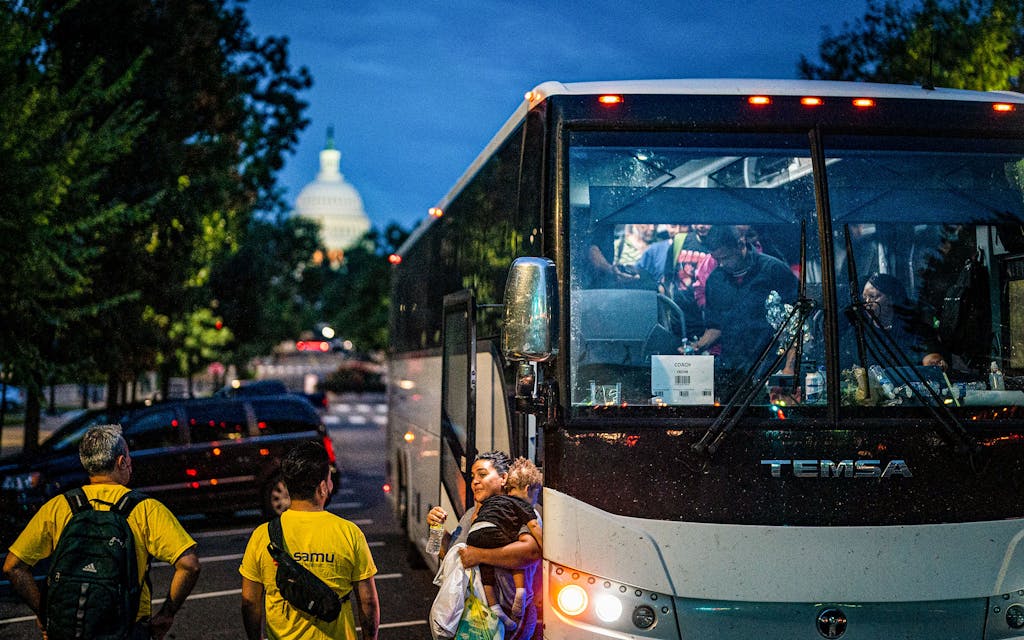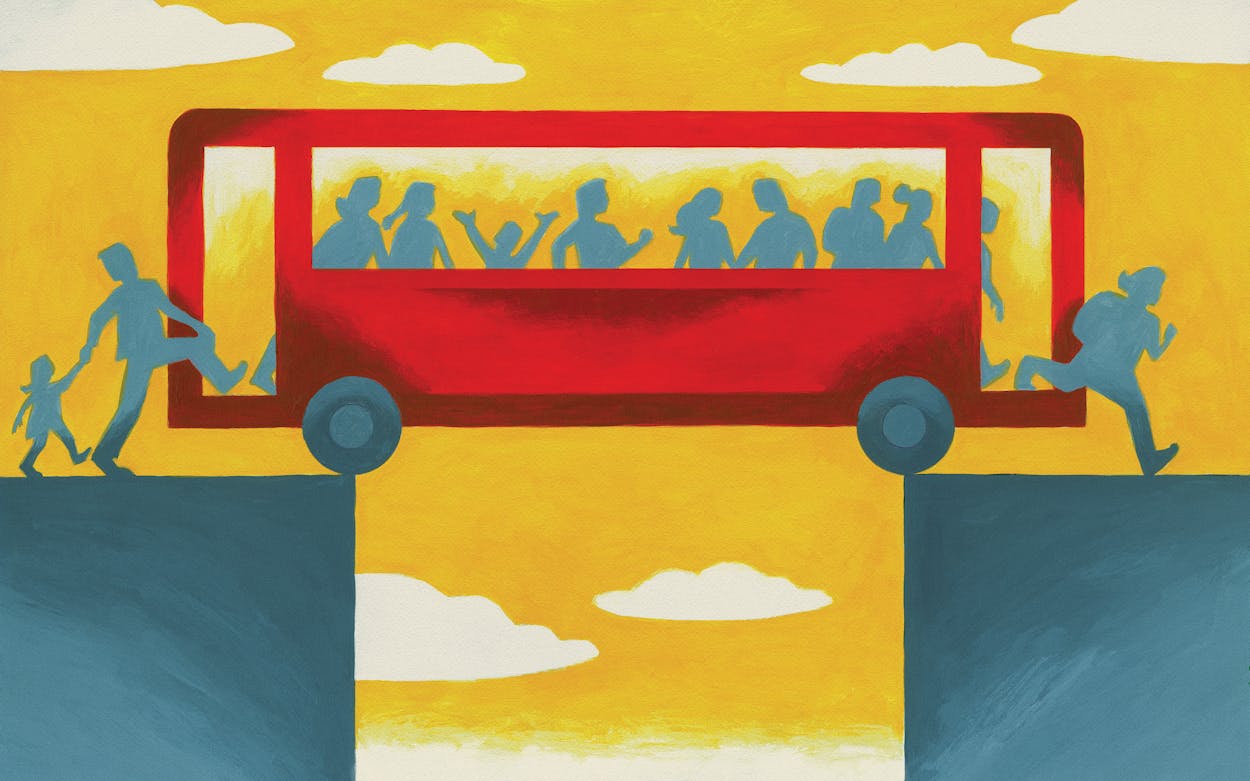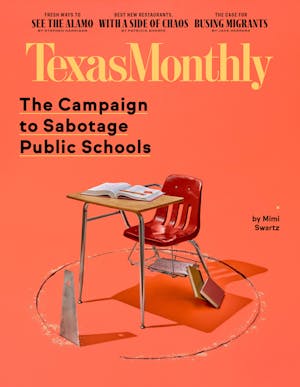On a muggy September night, Jean and his wife waited restlessly on a fume-filled patch of pavement in front of a Stripes gas station that serves as a Greyhound stop in Del Rio. Hours earlier, U.S. Border Patrol agents, who had arrested the couple when they crossed the Rio Grande into the city, dropped them off at the bus stop and suggested they make their way north or 150 miles east to San Antonio. Jean’s wife, visibly pregnant, sat down carefully in the parking lot, pressing her back against the cinder block wall of the Stripes. Nearby, a handful of families with young children huddled together, murmuring anxiously in Haitian Creole. A man on crutches gave me a wary look; a blind man tapped his cane against the ground.
This group represented only a few of the roughly 15,000 migrants who, in just one week in the fall of 2021, had crossed from Mexico into Del Rio. Most, including Jean and his wife, who declined to share her name, were Haitians who had fled gang violence and multiple devastating natural disasters in the country. While Border Patrol agents had detained or expelled most of them, they had decided that hundreds of these asylum seekers—those who were pregnant, disabled, or had young children—were too vulnerable. The agents had paroled them on their own recognizance so they could eventually fight their deportation cases in court. Jean showed me his ankle monitor and a slip of paper with “Notice to Appear” written at the top, in English, instructing him to check in at a U.S. Immigration and Customs Enforcement field office within sixty days. The agents, he said, had given him no further information.
When I asked Jean how he’d gotten to Ciudad Acuña, he responded, “Where is that?” I told him it was the Mexican city on the other side of the river. “Oh. And where are we now?” he asked. Del Rio, I said. Jean nodded slowly and then told me he needed to get to Florida, where he could stay with a cousin. “How do I get from Texas to Orlando?” he asked.
Like the majority of asylum seekers arriving that week, Jean had a sponsor he could stay with elsewhere in the country. But to get to their sponsors, migrants faced two options. They could buy bus tickets, which was difficult for many Haitians. Few spoke English or Spanish, and many, including Jean, had been robbed along their journey. Most, instead, relied on a second option: they appealed to volunteers and nonprofits for help.
In Del Rio, there weren’t enough volunteers, and bus tickets were sold out. Asylum seekers were trapped. Without shelter beds or motel rooms available, Haitians slept on benches and pavement. Nonprofit groups across the city worked around the clock to find any form of transportation to San Antonio, a much larger city where the migrants who had been processed and released could get to bus terminals, a major airport, and a bigger shelter. The last time I saw Jean and his wife, they were piling into the back of a black Chevrolet Tahoe driven by a Haitian American family who had come down from Dallas to help. But there weren’t enough good Samaritans to ferry everyone.
On that night, if I had told the volunteers and asylum seekers that the governor of Texas would send chartered buses to help migrants travel to cities such as New York and Chicago, for free, they would have cheered. It would’ve seemed too good to be true.
Seven months later, Governor Greg Abbott began doing just that. On April 12, the state dispatched a charter bus to Del Rio, which had continued to struggle with high numbers of asylum seekers. Local volunteers with the Val Verde Border Humanitarian Coalition, a nonprofit cooperating with the Texas Division of Emergency Management, explained to the migrants at a resource center that a “Texas state bus” was headed to the nation’s capital, and about thirty boarded. The bus rolled 1,700 miles to Washington, D.C., where it dumped them near Union Station in front of the building that houses Fox News. The coalition had alerted immigrant advocates in D.C. that a bus was coming, but volunteers didn’t know when or where it would drop its passengers, so no one was there to meet the asylum seekers. As exhausted individuals piled out, Fox journalists recorded video, and the story ran as front-page news across the country. The images from that day were upsetting; it appeared to be a crude PR gambit. Abbott was toying with migrants’ lives to own the libs.
The governor dispatched dozens more buses, eventually picking a handful of Democrat-run cities to surprise, including New York, Chicago, and Philadelphia. At each destination, volunteers mobilized to welcome the new arrivals, but they often struggled to do so effectively. Local mayors argued that Abbott was intentionally making the situation more difficult by sending buses unannounced. A source in the New York City mayor’s office told me that “the state of Texas has not coordinated with us at all.” Not to be outdone, Florida governor Ron DeSantis and then–Arizona governor Doug Ducey also began sending migrants from the border to northern cities, the former from Texas to Martha’s Vineyard, an island with no immigration nonprofits.
“Despite the cruel intentions by Governor Abbott, it really is a critical resource. That’s why we’ve never called for the buses to stop.”
Abbott, who declined a request for an interview, has elsewhere staunchly defended the plan he popularized. “Texas’s busing strategy has successfully provided much-needed relief to our border communities overwhelmed by the historic influx of migrants caused by President Biden’s reckless open border policies,” he said in November. Leaders in the states receiving migrants have different words for the scheme. New York mayor Eric Adams accused Abbott of using “innocent people as political pawns to manufacture a crisis.” Both Philadelphia mayor Jim Kenney and a spokesman for Chicago mayor Lori Lightfoot called the bus plan “racist.”
The coordinators of Abbott’s busing program at TDEM claim that it’s run no differently from evacuations on the Gulf Coast during hurricanes, but the treatment of migrants reveals that the scheme is often mean-spirited by design. On December 24, buses dropped more than one hundred asylum seekers in front of Vice President Kamala Harris’s residence in D.C. during a brutal cold front. Some of them were wearing only T-shirts. Given that it was one of the coldest Christmas Eves in the city’s history, volunteers who greeted them begged Texas officials to drop the migrants off at Union Station or a church shelter. The governor’s office refused.
W. Nim Kidd, the head of TDEM, told me that the first bus to D.C. was supposed to drop off its passengers by Union Station, just down the street, instead of the Fox News offices, but the driver “got confused.” When asked if it was practical to drop passengers at the vice president’s residence, Kidd said, “I don’t want to take away from the governor’s message; he has picked certain destinations, [and] those are his words, not mine. But I want to be clear to you that [the choice of cities] was also dependent on where the migrants want to go.”
Despite the harm Abbott’s busing scheme at times has caused, the concerns behind it should not be dismissed. He’s correct that border cities in Texas lack the resources to deal with historic numbers of asylum seekers. Last year Border Patrol agents encountered a record 2.4 million migrants on the border, more than half of whom crossed in through Texas. Border crossers have had to sleep on the streets in Del Rio, Eagle Pass, and El Paso, and residents and migrants alike have expressed fears of robbery and violent crime in this gyre of vulnerability and desperation.
Abbott also grasps what the rest of the U.S. has been slow to admit: that Texas shouldn’t have to shoulder so much of the responsibility for dealing with the consequences of the country’s broken asylum system. He points the finger at Biden, who as president could do more to slow border crossings. But Biden’s ability to curtail the crisis is limited. Surveys of migrants have shown that few keep up with news of current White House policy. And as Biden’s predecessor, Donald Trump, learned, U.S. border policy is only one component of what drives migration.
“Deterrence” policy discourages only those who have other options, and many migrants plainly don’t. The current emergency is a widespread refugee crisis. Asylum seekers are fleeing authoritarian governments in Cuba, Nicaragua, and Venezuela; political crises in Haiti and Peru; cartel warfare in Colombia, Honduras, and Mexico; and climate change–fueled drought in Guatemala. If anything, rates of migration are likely to increase in the coming years.
To face this growing crisis, the U.S. needs to move asylum seekers out of overwhelmed border cities to sponsors and shelters around the country. It’s not just Texan border residents who would benefit—migrants would too.

Proof of the busing program’s potential can be found back in Del Rio. There, TDEM works hand in hand with a selection of nonprofits: “They’re the face of the program,” Kidd explained.
Some of those nonprofit leaders are now among the busing program’s most ardent supporters. Back in April, Tiffany Burrow, director of operations for the Val Verde Border Humanitarian Coalition, whose volunteers I had met at the Stripes in 2021, rode with migrants on one of the first buses to monitor their treatment. She said the drivers and security guards on the trip (there are at least two on every bus) were professional and respectful. The vehicle had air conditioning, a bathroom, and onboard Wi-Fi, which migrants used to contact their families. Passengers were given water and rationed ready-to-eat meals.
Not all the buses appear to have been as well-run: when the first one arrived in Philadelphia, in November, volunteers had to rush a ten-year-old girl to the hospital, where she was treated for severe dehydration and a fever. Burrow said the conditions, though, are generally safe and acceptable. And while she doesn’t endorse the buses dropping off migrants on politicians’ doorsteps, she thinks the rest of the service makes up for it. Now, when asylum seekers are paroled in Del Rio, she gives them a sort of orientation, showing them a map (“This is Texas; this is D.C.”) and explaining what to expect upon arrival. “I wouldn’t have been able to endorse it had I not participated in it myself,” she told me. Thousands of migrants have made the decision to get on board.
On the other side, volunteers in D.C. said coordination between them and those in Texas was limited when the first buses arrived. But now, before every bus leaves Del Rio, Burrow contacts a point person within the large mutual-aid networks that have grown in the district and other cities, giving them a drop-off location and a passenger count, including special cases such as a mother traveling with a young infant or a traveler who speaks only an Indigenous language. Often, TDEM will share live ETAs with Burrow if buses encounter traffic or mechanical issues, and she then updates the volunteer networks in real time.
In D.C., Amy Fischer, a core organizer with the Migrant Solidarity Mutual Aid Network, is Burrow’s primary contact. Fischer is outspoken in her opposition to Abbott and how his program is run, but she “wholeheartedly” believes it has helped many migrants. “For years, advocates have called for more coordinated transportation—the job of helping the people arriving on the border shouldn’t have to fall entirely on border communities,” Fischer said. “Despite the cruel intentions by Governor Abbott, it really is a critical resource. That’s why we’ve never called for the buses to stop.”
There are simple ways Abbott could improve his busing program. Coordinating with the governments of destination cities would alleviate some of the burden on unpaid, overworked volunteers and allow those cities to prepare to shelter asylum seekers, which has often been a struggle. The state could exercise more due diligence to ensure migrants are fully aware of where they’re heading and what awaits them there. It could include more destinations to help asylum seekers whose sponsors live elsewhere in the country. And orders of magnitude more asylum seekers could be helped. Abbott’s program is moving only a fraction of those who show up at the border.
Kidd said the program is “primed to expand,” but the politics are tricky. For now, the buses leave only from Del Rio, Eagle Pass, and Laredo; along the border, many Democrat-run cities don’t want to participate in a busing scheme that Abbott has used as a cudgel against Biden. (Last fall, El Paso briefly ran its own $2.1 million busing program, which, while modeled after Abbott’s program, included coordination with the governments of destination cities.)
Expansion also would be costly. Between April and January, the state spent about $37 million to bus more than 16,700 migrants, at a rate of around $2,200 per passenger, along routes where commercial bus services such as Greyhound charge between $250 and $400 one way. Part of the expense arises from paying for security and from keeping the private charter company on standby in case there’s a surge in demand.
The costs don’t concern Kidd, however. For one thing, he said the Legislature has furnished TDEM with enough money to bus passengers from additional Texas border towns to even more northern cities, and that if needed, he can call up “infinitely more buses.” Kidd also advised critics to consider the impacts on “schools and health care” if these asylum seekers were to stay in Texas, as well as the human toll—children sleeping on streets, for instance—that can’t be measured in dollars.
Funding for expansion would be downright modest compared with that of programs such as Operation Lone Star, Abbott’s deployment of the National Guard on the border, which cost the state $4 billion in just its first fourteen months. For that price, Texas could have bused every migrant Border Patrol agents encountered on the Texas and California borders in the 2022 fiscal year. And if the program were operated humanely, the federal government could pick up some, if not all, of the tab. For the past eight years, the Federal Emergency Management Agency has provided funding to border nonprofits that charter transportation, and under Trump, Border Patrol sent government buses hundreds of miles north to parole migrants in cities including San Antonio and Albuquerque.
The program could feasibly garner bipartisan support: when
Democratic governor Katie Hobbs took office after Ducey in Arizona, she said she would keep his busing program in place but would try to send migrants to their final destinations, instead of to a handful of Democratic downtowns. If Abbott’s busing program is too politically toxic for Biden or other Democrats to support, that is partially the governor’s fault: he has gone out of his way to use the measure as a protest against the Biden administration. Abbott may have accidentally created a compassionate system, but it’s disguised as a cruel one, much to the satisfaction of the more pugilistic members of his base.
But he’s right to call out Democratic leaders who speak grandly about how the U.S. should “welcome migrants”—right up until they’re asked to do their part. In the fall, D.C. mayor Muriel Bowser said her city was not equipped to accept more asylum seekers from Texas. In January, after visiting El Paso, New York City’s Adams told Politico that “there’s no more room in New York . . . we are at that point.” Del Rio and El Paso, of course, don’t have the luxury to choose whether to host thousands of asylum seekers. Across the country, richer, larger cities have a duty to take on more of those in need.
Busing has inevitably become a front in the culture war, but even when migrants have been dumped in front of news cameras, many have expressed gratitude for the ride across the country. A Venezuelan who arrived in D.C. in April on one of the first buses told me recently that he understood that Abbott had played politics by sending asylum seekers like him out of Texas. But in Del Rio, he’d been stranded with nowhere to sleep, while in the nation’s capital, volunteers had helped him get an apartment, a work permit, a job, and a driver’s license. “I prefer not to cast any judgment on the man,” he said. “He did a good thing for me by sending me here.”
This article originally appeared in the March 2023 issue of Texas Monthly. Subscribe today.
- More About:
- Politics & Policy
- Greg Abbott
- Del Rio







